- Quick Read
- Deep Read ( 7 Min. )

Why is Christian Science in our name?
Our name is about honesty. The Monitor is owned by The Christian Science Church, and we’ve always been transparent about that.
The Church publishes the Monitor because it sees good journalism as vital to progress in the world. Since 1908, we’ve aimed “to injure no man, but to bless all mankind,” as our founder, Mary Baker Eddy, put it.
Here, you’ll find award-winning journalism not driven by commercial influences – a news organization that takes seriously its mission to uplift the world by seeking solutions and finding reasons for credible hope.
Explore values journalism About usIn Today’s Issue
Monitor Daily Podcast
- Follow us:
- Apple Podcasts
- Spotify
- RSS Feed
- Download
TODAY’S INTRO
Modern Europe’s third seismic shift
 Mark Sappenfield
Mark Sappenfield
Welcome to today’s Daily. We’ve got stories for you on the new U.S. Supreme Court term, which will aim to deepen the court’s conservative revolution, as well as our weekly roundup of progress around the world. (No, the Republic of Super Neighbors is not the next Marvel film.)
Meanwhile, New Hampshire is fighting tooth and nail to keep its place on the presidential primary calendar, though many Democrats are not impressed. And Pakistan appears to finally be realizing that its long-standing support of the Taliban might not be the greatest idea.
But Ned Temko’s Patterns column prompted me to reach out to him. Is it really as big a deal as it sounds? Yes, he says. It is.
The subject of the column is the European Union. But it’s really much more about what Ned calls “the third seismically redefining event of modern European history.” So, a big deal. It’s about Europe’s vision for what it wants to be going forward.
For years, admitting additional Eastern European members was not a priority. The EU had other things to deal with, most particularly the historic number of migrants arriving from Africa and the Middle East.
But the Ukraine war has underscored the importance of rethinking Europe’s most prestigious club. Ned says it is a new inflection point in European history, following World War II and the Cold War. There’s a new desire to expand the tent of membership – to bring more countries in and trust the influence of the EU to drive change where democratic or economic progress is needed.
Ukrainian President Volodymyr Zelenskyy has a compelling argument. Central to his plea to join the EU, Ned says, has been the fact that Ukrainians “are sacrificing their livelihoods and even their lives not merely to defend their country against an invader, but in defense of a Western, democratic way of life.”
Share this article
Link copied.

Help fund Monitor journalism for $11/ month
Already a subscriber? Login

Monitor journalism changes lives because we open that too-small box that most people think they live in. We believe news can and should expand a sense of identity and possibility beyond narrow conventional expectations.
Our work isn't possible without your support.
The Explainer
As Supreme Court starts new term, how far right is it headed?
A theme of the term is likely to be consequences, with the court wrestling with the fallout from some of its landmark conservative rulings.

The U.S. Supreme Court began a new term this week, and it began with a dose of skepticism.
During oral argument on Tuesday, several justices – including members of the high court’s robust conservative majority – questioned an appeals court holding that a federal consumer protection agency’s fundraising mechanism is unconstitutional.
It’s unclear how the court will rule in the case, but the argument is an early indication that while this may be the most conservative Supreme Court in nearly a century, it still has limits.
In some cases, the high court is facing the reverberations of its recent landmark rulings. In other cases, the court could deliver more rulings that conservatives have long pushed for. And then there’s former President Donald Trump, who is facing 91 felony charges amid four cases in state and federal court.
But after a summer clouded by ethics controversies, the justices have returned to regularly scheduled programming to face, in various guises, the same question: How far right will they push the envelope?
As Supreme Court starts new term, how far right is it headed?
The U.S. Supreme Court began a new term this week, and it began with a dose of skepticism.
During oral argument on Tuesday, several justices – including members of the high court’s robust conservative majority – questioned an appeals court holding that a federal consumer protection agency’s fundraising mechanism is unconstitutional.
It’s unclear how the court will rule in the case, but the argument is an early indication that while this may be the most conservative Supreme Court in nearly a century, it still has standards and limits.
In some cases, the high court is facing the reverberations of its recent landmark rulings. In other cases, the court could deliver more rulings that conservatives have long pushed for. And then there’s former President Donald Trump, who is facing 91 felony charges amid four cases in state and federal court. Those cases are likely to be appealed and may reach the Supreme Court.
But after a summer clouded by ethics controversies, the justices have returned to regularly scheduled programming to face, in various guises, the same question: How far right will they push the envelope?

What are the big cases this term?
The argument Tuesday involved one of the term’s big cases, and one of the term’s big legal issues: the independence of federal agencies.
The even more conservative U.S. Court of Appeals for the 5th Circuit is a central player here. Some of the biggest cases the justices have agreed to hear this term involve appeals to rulings from that circuit, Tuesday’s case involving the U.S. Consumer Financial Protection Bureau.
In that case, the circuit court declared the agency’s entire funding mechanism unconstitutional – a mechanism that Congress has authorized for various federal programs for decades, including currently Medicare and Medicaid. During the argument, even some conservative justices struggled to understand the lower court ruling.
Congress may have “never gone this far” with that kind of funding mechanism before, said Justice Clarence Thomas, “but ... not having gone this far is not a constitutional problem.”
The Supreme Court-5th Circuit dynamic will be watched closely this term. Both courts have been reshaped in recent years, particularly by former President Trump. He appointed one-third of the current Supreme Court and six of 17 active 5th Circuit judges.
While moderate conservative justices rejected some of the more extreme arguments the court heard last term, experts say the 5th Circuit, which hears cases arising from deep-red Texas, Louisiana, and Mississippi, has been more cavalier.
“You might say, why does the court have this focus on administrative law [this term]? Or you might say, why is the 5th Circuit issuing these remarkably extreme opinions?” says Carolyn Shapiro, a professor at the Chicago-Kent College of Law.
“The 5th Circuit is doing some very extreme things, and the Supreme Court is almost always going to grant” appeals so those decisions can be reviewed, she adds.

What else can we expect?
Another theme of the term is likely to be consequences.
Since a six-justice conservative supermajority took control of the Supreme Court three years ago, several legal priorities – including expanding gun rights and eliminating the constitutional right to abortion and race-based affirmative action in college admissions – have been addressed. This term will also see the court wrestle with the fallout from some of those rulings.
In 2022, for example, the court held that the Second Amendment guaranteed everyone the right to carry a firearm. Any restriction on that right must be consistent with the “history and tradition” of American gun policy, the court added, with little elaboration.
In a case scheduled for argument next month, the justices will have to elaborate. Specifically, does this history and tradition test mean the government can restrict people who are subject to domestic violence restraining orders from carrying guns?
The abortion issue could also return to the high court. An effort to revoke federal approval for a widely prescribed abortion pill already reached the justices, on an emergency basis, earlier this year, where they granted an emergency stay keeping the pill available. It’s possible the court will be asked to give the case a full hearing.
“The Supreme Court seems to have sent very strong signals to the conservative legal movement that it’s open for business,” says Steven Schwinn, a professor at the University of Illinois, Chicago School of Law. “But it hasn’t fully thought through what that means down the road.”
Are there other cases about the “administrative state”?
Yes, and the court will likely be more interested in restricting federal agencies in these other cases.
In another case from the 5th Circuit, the court will decide if the U.S. Securities and Exchange Commission can impose civil penalties for securities fraud. The ruling could implicate the administrative powers of agencies from the Food and Drug Administration to the Postal Service.
But another case, and one of the most high-profile of the term, is asking the justices to overturn the Chevron doctrine.
The doctrine, first articulated by the Supreme Court in 1984, holds that federal courts must defer to an agency’s interpretation of ambiguous statutes if it’s based on “a permissible construction” of the statute. Conservatives charge that Chevron has given federal agencies too much regulatory power over Americans’ daily lives, and several justices have openly criticized the doctrine.
“Together [those three cases] all put the court in the position of making clear how far it really wants to go in terms of curtailing the administrative state,” says Jonathan Adler, a professor at Case Western Reserve University School of Law.
“The court has already cut back on Chevron, and the way the question is presented, the court could cut back more without directly overturning the decision.”
Consequences are also likely to come into play with the three administrative law cases. The court has been willing to limit agency power in recent years, for example, but it’s been careful to do so in a way that doesn’t throw into question decades of agency actions, says Professor Adler.
“This term, the ability of the court to continue to sound those themes without [creating] significant consequences is more concerning,” he adds. “The court is going to have to think more carefully about the potential consequences. ... We’ll see if that affects how the court decides cases.”

Wasn’t there lots of Supreme Court ethics news earlier this year?
Yes there was. Unlike other federal judges, Supreme Court justices are not subject to any formal ethics rules. And while people disagree over how big a problem it is, most agree that justices across the ideological spectrum have been able to make ethically suspect choices.
According to news reports, Justice Thomas and Justice Samuel Alito for years failed to disclose numerous gifts, including luxury vacations, from conservative donors and legal activists. Justice Sonia Sotomayor has been similarly criticized for reports that she encouraged public institutions to buy her books ahead of speaking engagements, and that she failed to recuse herself from cases involving her publisher.
“It heightens people’s concerns about the court, and to the extent they’re issuing opinions that are unpopular ... those concerns will continue,” says Professor Shapiro.
Justice Alito and Chief Justice John Roberts have brushed off the ethics concerns, the latter citing “separation of powers concerns and the importance of preserving judicial independence.” The court did adopt tighter reporting rules over the summer, but Justice Brett Kavanaugh and Justice Elena Kagan have both said in the past month that the high court should take additional steps to address concerns about its ethics rules.
In a relatively surprising decision this week, Justice Thomas recused himself from a decision rejecting an appeal in a case involving efforts to overturn the 2020 election. Justices don’t have to explain recusal decisions, but the fact that a plaintiff in the case, John Eastman, clerked for Justice Thomas in the mid-1990s could be a reason. Still, court watchers say, it represents a departure for Justice Thomas, who had refused to recuse himself from similar cases in the past despite evidence his wife, Ginni, was involved in efforts to overturn the 2020 election.
The recusal “should not be big news,” said Joyce White Vance, a law professor and former federal prosecutor, on social media. “But in this day and age ... it is.”
Meanwhile, public approval of the Supreme Court is now at 40%, a record low, according to Gallup. Another potentially contentious term lies ahead.

Uptick in terror attacks strains Pakistan-Taliban friendship
What does it take to make a friend an enemy? Pakistan – once seen as sympathetic to the Taliban – is reassessing its relationship with the neighboring regime after a series of terror attacks on its soil.

- Quick Read
- Deep Read ( 5 Min. )
Relations between Pakistan and Afghanistan reached a new low this week following two suicide attacks in the western Pakistani cities of Hangu and Mastung. Pakistan’s caretaker government has since ordered all unauthorized immigrants, including an estimated 1.7 million Afghans, to leave the country by Nov. 1 or face deportation.
At the center of the dispute is the militant offshoot Tehreek-e-Taliban Pakistan (TTP), which Pakistan says is using Afghanistan as a safe haven and launch pad for attacks on Pakistani soil, an allegation Kabul denies.
“There is no doubt that attacks on us are coming from Afghanistan,” said Pakistan’s interior minister at a press conference Tuesday.
Pakistan has historically been sympathetic toward the Taliban, with whom they shared ideological and security interests. During the fall of Kabul, the Pakistani prime minister said the Taliban were “breaking the chains of slavery.” But Afghanistan’s failure to crack down on TTP activity has some rethinking the alliance. Not all Pakistanis back the government’s ultimatum, but many see an urgent need for change.
The question, says Pakistani diplomat Maleeha Lodhi, is “what kind of tough-love policy Islamabad is prepared to pursue to persuade the Taliban to respond to its security concerns.”
Experts see the crackdown on migrants as one way to rattle the saber.
Uptick in terror attacks strains Pakistan-Taliban friendship
Relations between Pakistan and Afghanistan have reached a new low this week following an uptick in terror attacks on Pakistani soil.
Two separate suicide attacks in the western cities of Hangu and Mastung claimed the lives of at least 60 people on Sept. 29, and prompted a controversial ultimatum: Pakistan’s caretaker government ordered all unauthorized immigrants, including an estimated 1.7 million Afghans, to leave the country by Nov. 1 or face forced deportation.
Central to the deterioration of ties between the governments is the relationship, perceived or real, between the Afghan Taliban and the Tehreek-e-Taliban Pakistan (TTP), colloquially known as the Pakistani Taliban. The militant offshoot emerged during what became known as the war on terror, which was led by the United States.
Pakistan says the TTP is using Afghanistan as a safe haven from which to launch terrorist attacks, an allegation Kabul has consistently denied.
Of the roughly two dozen suicide attacks carried out along the Pakistan-Afghan border since January, the majority can be attributed to Afghan citizens, says Sarfaraz Bugti, Pakistan’s caretaker interior minister.
“There is no doubt that attacks on us are coming from Afghanistan,” he said at a Tuesday press conference. On Wednesday, Pakistan’s army said an Afghan sentry had opened fire at the Wesh-Chaman border crossing and killed two Pakistani citizens, including a 12-year-old child.
Taliban spokesperson Zabihullah Mujahid urged Pakistan to reconsider its ultimatum. In a post on X, formerly Twitter, he called the threat of deportation unacceptable and was adamant that Afghan refugees were “not involved in Pakistan’s security problems.”
The events represent a sharp break from Pakistan’s historically sympathetic attitude toward the Taliban, with whom they shared ideological and security interests. For years Pakistan has provided the Taliban much-needed financial and diplomatic support, and during the fall of Kabul, when the Taliban reclaimed power as Western forces retreated, then-Prime Minister Imran Khan said the group was “breaking the chains of slavery.”
But what Pakistan regards as Afghanistan’s failure to crack down on TTP activity has some seeing this relationship in a new light. Not all Pakistanis back the government’s ultimatum, but many see an urgent need for change.
Sayed Zulfikar Bukhari, who serves as an adviser on international affairs in the Tehreek-e-Insaf party, Pakistan’s largest, argues that the inconsistency of Pakistan’s policy toward Afghanistan has had a destabilizing effect on the region.
“Really and truly, we need to think about why we’re meddling in a neighboring country’s problems,” he says. “I don’t think Pakistan has gained anything in terms of having a close relationship with Afghanistan.”

Suspicious alliance
After the collapse of the Soviet-backed administration of Mohammad Najibullah in 1992, Afghanistan became the theater of a long civil war that only ended when the Taliban – backed by Pakistan’s powerful Inter-Services Intelligence agency – took over the country in September 1996. Then, when the Taliban refused to extradite Osama bin Laden after the Sept. 11 attacks, U.S. President George W. Bush authorized a full-fledged military campaign to remove the Taliban from power and pressured Pakistan to become a front-line state in the war on terror.
In the decades since, Pakistan has often been accused of playing both sides in the war. This infamous “double game,” as it has been dubbed in the American press, allegedly manifests in Pakistan’s oscillation between covert support for and military operations against the Taliban leadership. The result, experts say, is an alliance fraught with suspicion.
In July, the chief of Pakistan’s politically powerful army, Gen. Syed Asim Munir, reminded Afghanistan’s de facto government of its commitment to ensure that its territory would not be used as a base for foreign terror operations. He also promised an “effective response” from Pakistan’s security forces should such attacks continue on Pakistani soil.
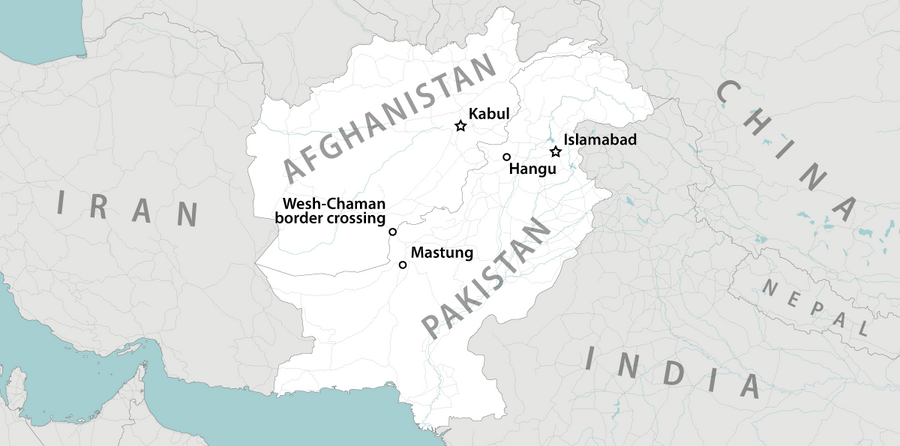
The recent suicide bombings in Mastung and Hangu have exacerbated tensions in what Farzana Shaikh, associate fellow at Chatham House’s Asia-Pacific program, describes as an already “uneasy” alliance.
“The Afghan Taliban, while they have certainly been the beneficiaries of Pakistan’s patronage, have always deeply resented the view that they are simply creatures of the Pakistani state,” Dr. Shaikh says. “What we find now is a very curious and some would say ironical situation where the Afghan Taliban, through their leverage on the TTP, have come to exercise the kind of control over some areas of Pakistan that would have appeared inconceivable some years ago.”
Tough love
Diplomat Maleeha Lodhi, who served as Pakistan’s permanent representative to the United Nations from 2015 to 2019, says it’s not going to be easy for Pakistan to extricate itself from this alliance, partly because the security concerns that initially drew Islamabad to the Taliban have not changed.
“The Taliban’s unwillingness to act against the TTP ... has strained Pakistan-Afghan relations, but stabilizing ties with its western neighbor remains a strategic compulsion for Pakistan given its unstable border with India,” she says. “The question is what kind of tough-love policy Islamabad is prepared to pursue to persuade the Taliban to respond to its security concerns.”
Experts see the crackdown on unauthorized migrants – which Mr. Bugti says is not aimed at Afghans, though most migrants in Pakistan are from Afghanistan – as one way to rattle the saber.
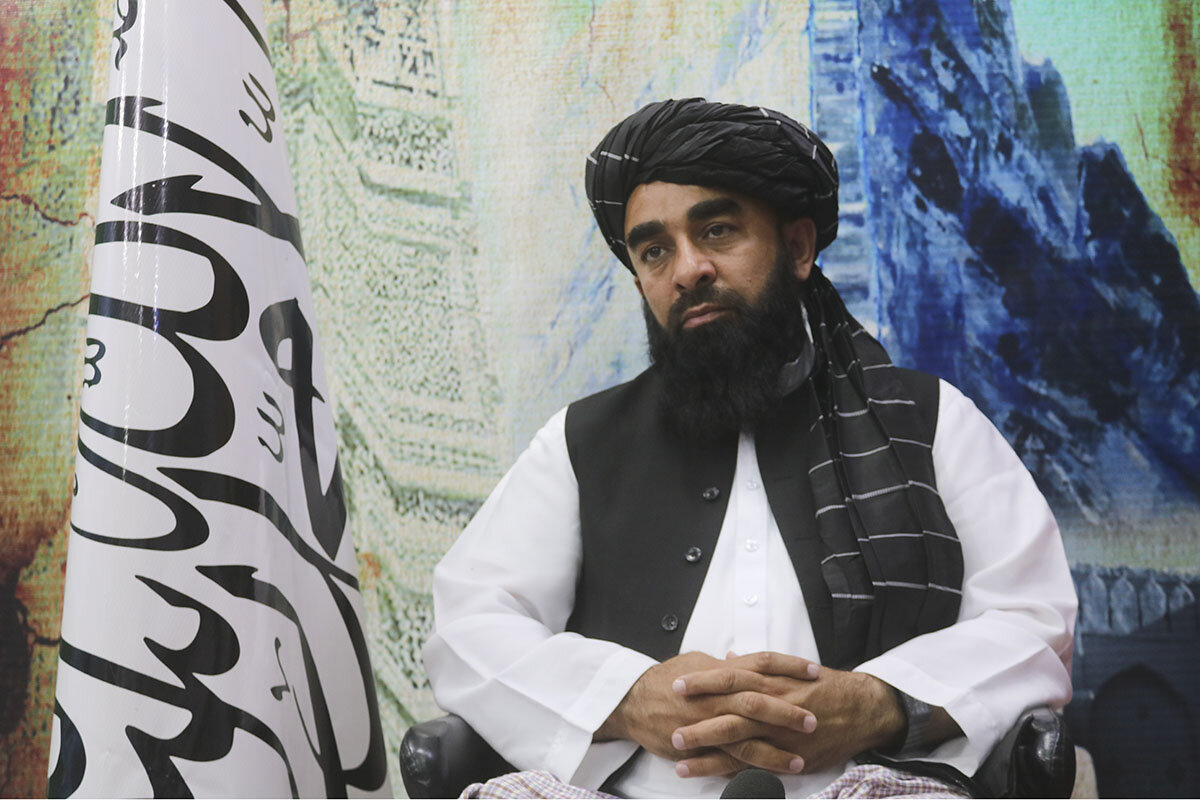
During the Soviet-Afghan war of the 1980s, approximately 6 million Afghan refugees moved to Iran and Pakistan in search of safety. Nearly 2 million more have fled their homeland since the Taliban retook Afghanistan in 2021, with many relocating to Pakistan.
Of the 4.4 million Afghans living in Pakistan today, authorities say 2.4 million have refugee status and are free to stay. Beyond ordering unauthorized migrants to voluntarily leave the country in the coming weeks, the Pakistani government has not announced any concrete proposals to repatriate the others. Given the insecurity of the Pakistan-Afghan border, it is not clear if such a policy is even feasible.
Human rights campaigners in Pakistan are cautioning against a knee-jerk reaction from the government.
Malaika Raza, the general secretary of the human rights wing of the Pakistan People's Party, argues that the state’s response toward asylum-seekers should be rooted in compassion.
“As a neighboring Muslim country, Pakistan holds a unique position to understand and empathize with the plight of Afghan refugees,” she says, noting that there are people in Pakistan who have family on both sides of the porous border and could also suffer from escalating tensions.
“It is not only our moral obligation but also a reflection of our compassionate society to extend our protection and support to these vulnerable individuals,” she adds.


Patterns
With wary eye on Moscow, Europe opens the door to Ukraine
Russia’s invasion of Ukraine is opening the European Union’s doors to Kyiv. Other candidate countries are clinging to its coattails. Joining the EU would take years, but the process would redraw the European map.

- Quick Read
- Deep Read ( 4 Min. )
For more than a decade, the 27-member European Union has been wary of admitting any more nations. More than half a dozen Eastern European and Balkan countries have been waiting in line for years.
But Russia’s invasion of Ukraine and the ongoing war there have changed all that. Now the modalities and time frame for EU expansion are at the top of the European agenda. And the top-priority candidate is Ukraine.
This week, European leaders are meeting in the Spanish city of Granada to discuss the first steps toward a new expansion, possibly involving an invitation to Kyiv to launch its accession process as early as the end of this year.
That process, like other smaller candidate countries’ negotiations, is bound to be fraught. All the applicants will have to meet tough budgetary, anti-corruption, and democracy requirements to be allowed into the EU. And the talks will stretch on until at least 2030. But the audaciously ambitious goal is to stretch the European Union into a wider partnership of democracies that would reach across the continent to the very border of Russia.
EU leaders are hoping that the expansion will redraw more than the continent’s economic map.
The aim is to answer Vladimir Putin’s invasion with a widened family of European democracies.
With wary eye on Moscow, Europe opens the door to Ukraine

It is a defining moment, one that has been drawing inevitably closer ever since Russian President Vladimir Putin sent his tanks and troops to try to subjugate Ukraine 19 months ago.
And while the decisions made in the coming weeks will involve the countries of the 27-member European Union, they will have important implications for the United States as well.
Because at stake is the prospect of a new political map of Europe, once the war in Ukraine is over, stretching the European Union into a wider partnership of democracies that would reach across the continent to the very border of Russia.
The vision is audaciously ambitious. It will depend significantly on how and when the war ends, since it would be hard to implement unless Ukraine regains control over all its territory.
Yet, with a rare show of urgency, EU leaders this week are embarking on a series of meetings to decide on the first steps toward making it a reality – possibly including the start of accession talks with Kyiv by the end of this year.
In the Spanish city of Granada, EU members met Thursday with all their neighbors in the 47-member European Political Community, before an informal EU leaders’ summit meets there on Friday.
The fact that a major eastward expansion is now on the EU’s agenda is a direct result of Mr. Putin’s invasion of Ukraine.
And it underlines another reality: While Washington has been the indispensable leader of a united Western response to Mr. Putin’s invasion, the war itself is happening on European soil. It is the largest armed conflict on the continent since World War II.
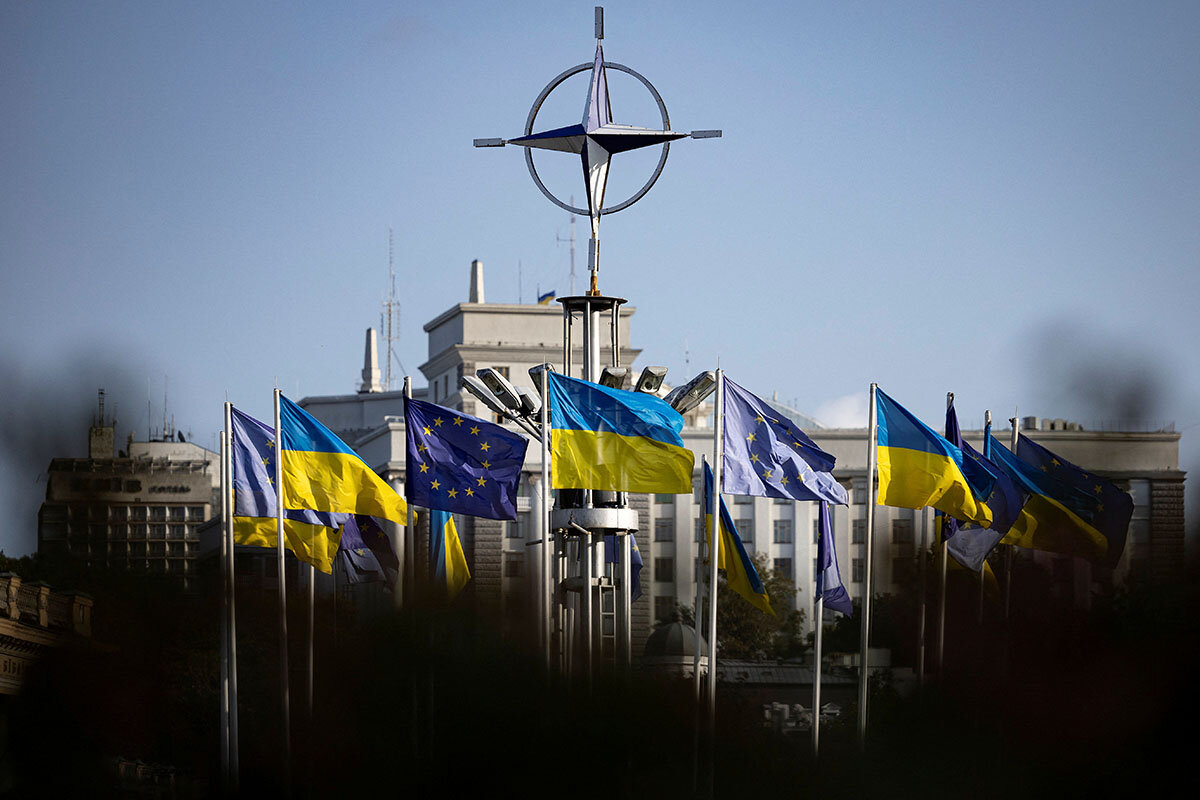
As with that world war and the fall of the Iron Curtain in 1989, the Ukraine conflict looks certain to leave Europe’s political alignment unrecognizably different.
The EU’s own roots lie in the post-World War II division of Europe, which left the Soviet Union controlling its eastern states. It began as a narrow coal-and-steel agreement between historic enemies Germany and France, part of a wider U.S.-backed effort to promote cooperation, economic development, and a lasting peace in Western Europe.
In the decades that followed, the Franco-German partnership grew into a thriving community of more than a dozen European countries, grounded in trade and economic cooperation but also increasingly in a shared democratic identity.
After the fall of the Soviet Union, the group expanded again, but at a decidedly deliberative pace. It took 15 years to begin adding nearly a dozen former Soviet states.
The hope was that EU membership would not only bring these countries economic benefits but also reinforce their commitment to a democratic future.
That second goal has proved tricky. The new member states have indeed prospered, and most have integrated politically as well. But two former Soviet satellites, Poland and Hungary, are now under governments that openly espouse “illiberal democracy,” restricting minority rights, independent news media, and the rule of law.
Until now, that cautionary tale has dampened enthusiasm in many European capitals for the prospect of further expansion. More than a half-dozen other former east-bloc states have been kept waiting in line for EU membership for over a decade.
The new mood underscores how dramatically the Ukraine invasion has altered EU thinking.
For years, the EU had been actively engaging with the Kremlin. EU states – especially Germany, the bloc’s leading economy – had come to rely on Russian imports for much of their energy. That link is all but severed now, and it is hard to see how it might be restored.
On the political front, in an even more fundamental rupture, the EU has for the first time earmarked aid, including military supplies, to a country at war, Ukraine.
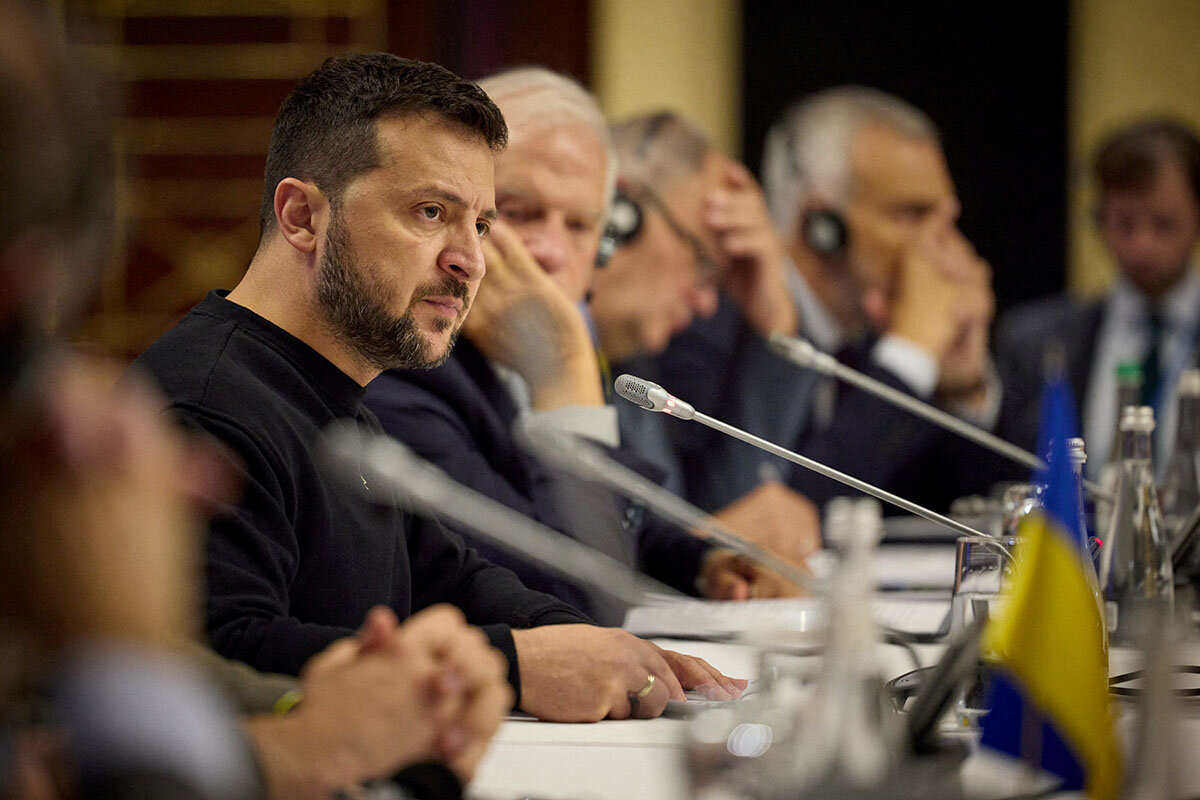
And EU foreign ministers this week traveled to Kyiv for their first-ever joint consultation meeting abroad. They met President Volodymyr Zelenskyy ahead of this week’s initial consultations in Granada on admitting Ukraine and the other Eastern European candidate countries.
There remains a raft of practical issues still to be worked out within the EU before new members could be admitted. One that could prove especially complex is how the additional budgetary costs would be shared among existing member states – any one of which, under current EU rules, could veto the expansion.
And the current target date is 2030, seven years away.
But the main challenge is to learn the lesson of the last EU expansion to the east – that economic prosperity does not automatically translate into a democratic ethos.
Whether Hungary or Poland will yet reembrace the EU’s democratic mainstream remains unclear. In Poland’s case at least, the start of an answer could come soon, in a fiercely contested national election on Oct. 15.
But EU leaders are hoping that the new planned expansion will redraw more than the continent’s postwar economic map.
The aim is to answer Mr. Putin’s invasion with a widened family of European democracies.

The first Democratic primary is approaching. But where?
With a few months until primary season, Democrats are roiled over which state should go first. The dispute pits a fresh idea against tradition – and could affect voter participation and enthusiasm.

- Quick Read
- Deep Read ( 6 Min. )
After decades of Iowa and New Hampshire kicking off the presidential primary season, the Democratic National Committee last year upended that tradition. At the behest of President Joe Biden, who wanted to give voters of color more say in the process, the DNC tapped South Carolina to cast the first votes in 2024.
But just four months before the voting is scheduled to begin, New Hampshire is not going along with the plan. Democratic leaders here say they’re planning to thwart the DNC’s calendar. Even if it means holding a primary election in which President Biden isn’t on the ballot. Even if it means being stripped of half their delegates to the convention next summer, as the DNC is threatening to do.
In New Hampshire, officials say their hands are tied by a state law that requires New Hampshire to hold its primary one week before any other state primary.
While the dispute may seem minor, the confusion and frustration could have real costs. In a reelection year that should be all about party unity, some Democrats worry it could dampen enthusiasm and turnout in this and other key swing states.
“We have the DNC trying to tell us not to participate in an election,” says Kathy Sullivan, a former New Hampshire Democratic chair. “That’s not democracy; that’s just plain stupid.”
The first Democratic primary is approaching. But where?

Roughly four months from now, Democrats will hold their first primary contest for the 2024 presidential race. The outcome isn’t really in question – President Joe Biden currently faces only nominal opposition for his party’s nomination.
What is in question is the location.
Officially, that first vote will take place in South Carolina. After decades of Iowa and New Hampshire kicking off the presidential election calendar, the Democratic National Committee last year upended that tradition at the behest of President Biden, who requested that “voters of color have a voice in choosing our nominee much earlier in the process.” The DNC tapped South Carolina – which has a sizable population of Black voters, and perhaps not coincidentally also revived Mr. Biden’s 2020 campaign – to go first.
But talk with Democratic officials here in New Hampshire, including some of Mr. Biden’s most ardent supporters, and they’ll tell you that’s not happening.
“Of course” New Hampshire is going to go first, insists the state’s Democratic Party chair, Raymond Buckley, wiping sweat off his brow at an unseasonably warm picnic with local Democrats in Amherst last month. “Didn’t I say that a year ago?”
While the Granite State has not yet officially filed a waiver declaring its intention to thwart the DNC’s calendar, New Hampshire Democratic leaders flatly say they’re planning to do just that. Even if it means holding a primary election in which Mr. Biden isn’t on the ballot. Even if it means being stripped of half their delegates to the national convention next summer, as the DNC is threatening to do.
On one level, the dispute may seem minor. But like hosting the Olympics, “first in the nation” primary status comes with real prestige, power – and money. Every four years, presidential campaign staffers and members of the media have descended on New Hampshire, filling hotel rooms and restaurants, while local television and radio stations are inundated with ads.
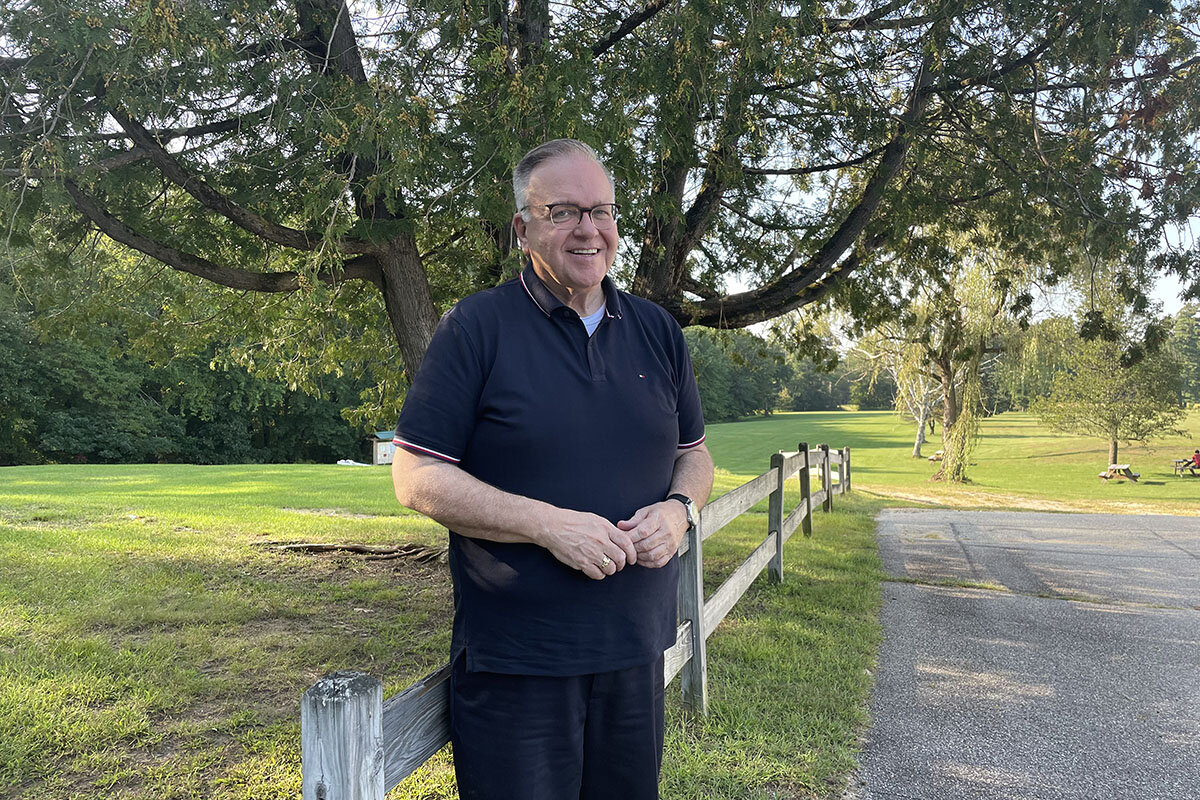
And some say the confusion and frustration over the calendar changes could have real costs. In a reelection year that should be all about party unity, it could dampen enthusiasm and turnout in this and other key swing states – whose electoral votes could well determine the outcome in November.
“New Hampshire will have the first primary, period. It doesn’t matter what the DNC does,” says Kathy Sullivan, a former New Hampshire party chair and DNC member. She accuses the national party of effectively “turning [its] back on a very hardcore group of Democrats” who want to show their support for the president.
“We have the DNC trying to tell us not to participate in an election,” she says. “That’s not democracy; that’s just plain stupid.”
Iowa and Georgia also in limbo
The standoff between New Hampshire and the national party has been going since last December, when the DNC’s Rules and Bylaws Committee officially approved the new primary calendar, putting South Carolina on Feb. 3. New Hampshire and Nevada were supposed to follow on Feb. 6, with Georgia and Michigan at the end of the month.
Iowa was taken out of the Democrats’ early lineup altogether, after a mishap-ridden 2020 caucus. But Iowa Democrats are considering implementing a mail-in caucus in mid-January, anyway. And Georgia, which was given an early slot by the DNC, is having trouble complying with the new calendar. The state’s Republican governor sets the primary date and has said he would only move the Democrats’ primary if the Republican National Committee agreed to move as well – which the RNC does not appear inclined to do.

In New Hampshire, officials say their hands are tied by a state law that requires New Hampshire to hold its primary one week before any other state primary – which the Republican-controlled legislature and governor have announced they will uphold.
Officials at the DNC appear all but resigned to the fact that New Hampshire will probably go forward with a January primary date. If that happens, DNC rules state that any Democratic candidate who campaigns there will be ineligible to win the state’s delegates to the national convention. The Biden campaign, under this scenario, is not expected to put the president’s name on the ballot.
“This is very much Biden’s decision. He is not going to put his name on the ballot,” says Elaine Kamarck, a member of the DNC’s Rules and Bylaws Committee.
Mr. Biden could, however, still win the state if voters choose to write in his name – an outcome that many New Hampshire politicos and party operatives are anticipating.
“At the end of the day, we’re going to be first, and Biden’s going to win the primary,” says Mr. Buckley. “Then we’re going to carry the state for Biden-Harris in November – and we’ll all move on.”
A looming embarrassment
But some here worry that the whole debacle could dampen turnout in a state that has transitioned from reliably red to purple. New Hampshire’s Democrats may see little reason to vote in an unsanctioned primary – and, critically, many independent voters may opt to participate in the Republican contest instead. Any independent who votes in the Republican primary will be registered as a Republican from that point on unless they change their registration back to independent.
T.D. Floras, a sales manager from Nashua, has voted Democratic most of her life, but says she’s planning to vote in the Republican primary next year because she doesn’t want to “throw away” her vote in an unsanctioned Democratic election. While she says it’s “really unlikely” she would vote for a Republican in November, she adds that “anything can happen.”

“People here take the primary here very seriously,” says Jim Demers, who co-chaired former President Barack Obama’s New Hampshire campaigns and steered Hillary Clinton’s in 2016. “If there is no effort made to write in Biden’s name, then a lot of independents are going to vote in the Republican primary. I think it’s important to keep those Republicans on the Democratic side.”
The DNC says it’s confident Mr. Biden will win the New Hampshire primary regardless of when it happens and whether he’s on the ballot or not. State polls have the incumbent president leading his current opponents, Robert F. Kennedy Jr. and Marianne Williamson, by as much as 50 to 70 percentage points.
But some warn it would be an embarrassing turn of events should the president somehow lose the first primary contest of the season, even an unsanctioned one.
“The DNC has this false belief that the New Hampshire primary will be irrelevant,” says Ms. Sullivan. “The first headline is going to be who wins the New Hampshire Republican primary. The second headline is either going to be: Biden wins on a write-in, or RFK Jr. wins the New Hampshire Democratic primary. What’s the bad headline for Biden?”
Still, national party officials say the embarrassment will be entirely New Hampshire’s, if the state long known for taking presidential politics seriously winds up backing Mr. Kennedy or Ms. Williamson in a low-turnout election that doesn’t feature the sitting U.S. president on the ballot.
“New Hampshire will either go second as we suggested, or become pretty much irrelevant to the process,” says Ms. Kamarck with the DNC’s Rules and Bylaws Committee. “The real question is, what happens in 2028?”
Staff writer Sophie Hills contributed to this report.

Points of Progress
The power of togetherness, to share knowledge – and a meal
In our progress roundup, one Paris neighborhood makes a big city smaller with a dinner for hundreds. And in Senegal, farmers don’t need to read to gain knowledge from advisers and peers – they use their cellphones.
The power of togetherness, to share knowledge – and a meal
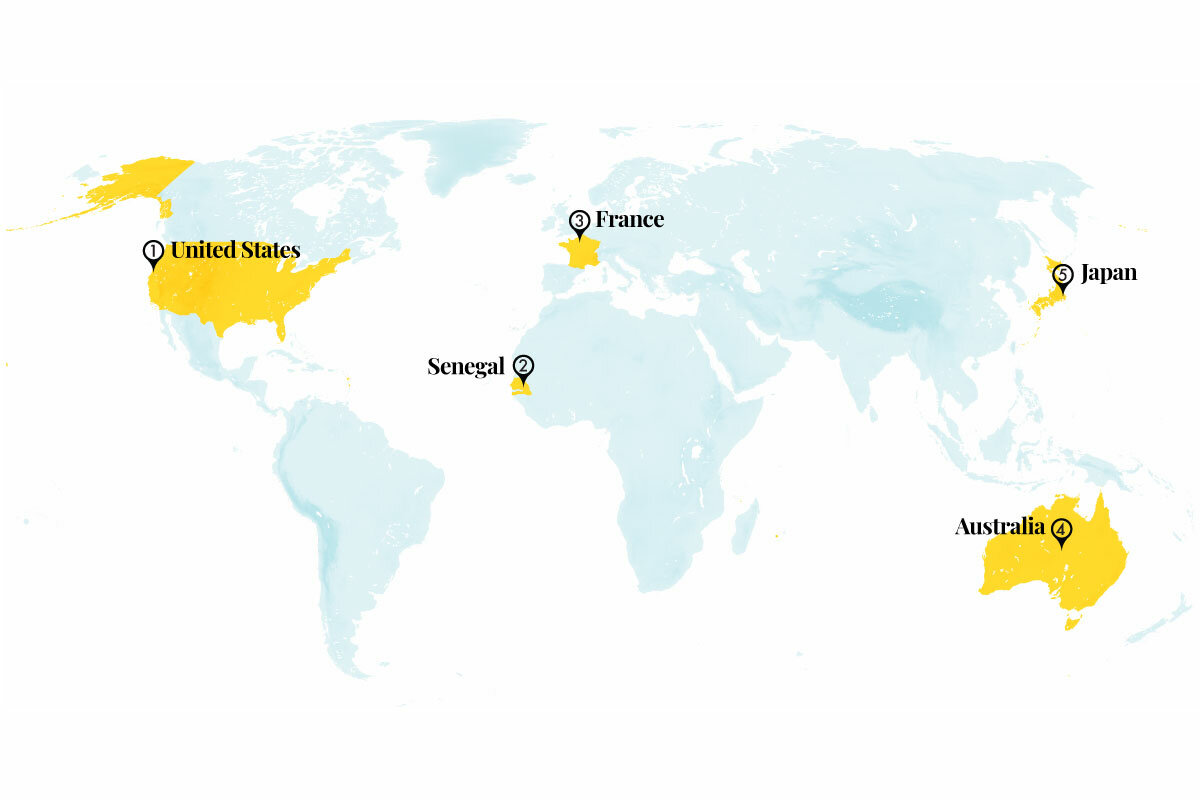
1. United States
Scientists synthesized speech and facial expressions from brain signals for the first time, creating a speaking avatar for a woman with paralysis. The brain-computer interface enabled Ann Johnson to communicate five times faster than her current device allows.
On the surface of Mrs. Johnson’s brain, the team placed a thin rectangle of 253 electrodes, which interpreted electrical impulses that usually would go to the larynx, face, tongue, and jaw. While her attempts at speech do not result in sound, Mrs. Johnson’s weeks of repeating a small vocabulary taught the artificial intelligence deep-learning models her brain patterns along with the 39 phonemes in English – the individual units of sound rather than whole words. An algorithm used a recording of Mrs. Johnson speaking at her wedding so that the avatar mimics her voice from before the paralysis.
The system accurately deciphered every word of about half of Mrs. Johnson’s sentences, and people on a crowdsourcing platform correctly interpreted the digital avatar’s facial expressions most of the time.
“It let me feel like I was a whole person again,” Mrs. Johnson wrote.
Researchers hope the breakthrough could lead to a widely available wireless version of the technology in the next decade.
Sources: University of California, San Francisco; Nature; The New York Times
2. Senegal
Senegalese farmers are using WhatsApp voice notes for vital information that is improving the way they work. Nearly half of Senegal’s population cannot read or write, owing to educational inequities and the primarily oral nature of local languages. A 15,000-person network of more than 30 WhatsApp groups is keeping farmers connected with agriculture advisers, researchers, local nonprofits, and each other.
Last year, as the war in Ukraine caused fertilizer prices to skyrocket, threatening the country’s already tenuous food supply, WhatsApp allowed farmers to discuss cost-friendly alternatives. Senegal’s agency for agriculture used the app to share detailed messages on techniques for a homemade fertilizer that is cheaper and faster, and yields harvest increases of 30%, some farmers reported. The groups have also helped users overcome connectivity issues since they can send voice notes for the recipient to listen to when they gain reception.
“I want to open myself to the world, I want to learn so many things,” said fruit farmer Ousmane Coly. “We all speak Wolof, Diola, and some Manding that are difficult to write. Voice notes let us carry on the dialogue.”
Source: Rest of World
3. France
The Republic of Super Neighbors is re-imagining urban life in Paris. In the 14th arrondissement, some 1,000 to 2,000 Parisians have forged an inclusive community that holds cultural exchanges, weekly brunches, and an annual banquet – where hundreds of residents eat together at a long table in the middle of Rue de l’Aude, a central street. The group, which started in 2017, is part of a broader movement to refocus city life through a lens of neighborliness, mutual aid, and close interaction.
The République des Hyper Voisins seeks to improve health, mobility, public spaces, and the environment in its neighborhood on the Seine’s Left Bank. In one project, the city of Paris is helping fund a new health clinic with a staff of 10. And the Super Neighbors collaborated with a nonprofit to install bins and annually collect 60 tons of organic waste for compost.
A qualitative study of the Super Neighbors and of two other volunteer initiatives in Paris during the pandemic recommended more such programs to strengthen communities.
“Conviviality is not just a good feeling,” said Patrick Bernard, a resident who conceived the Super Neighbors group. “It can become a powerful asset, an essential economic and social agent in the construction of tomorrow’s cities.”
Sources: The Guardian, The New York Times, La 27e Région-Camille Arnodin
4. Australia

In an unprecedented effort, Indigenous rangers are using controlled, “right-way” burns across thousands of square miles of desert in central and western Australia. After La Niña rains encouraged the growth of invasive buffel grass, officials warned that up to 80% of the Northern Territory could burn this coming season.
Groups from a dozen Indigenous Protected Areas are working primarily from helicopters, dropping incendiary devices to start controlled burns over difficult-to-access arid lands. Because dry areas tend to have few trees, fires stay close to the ground and remain controlled. For areas near cultural sites and threatened species’ habitats, rangers use drip torches to start fires on the ground.
Roughly 60% of Australia’s desert mammal species have gone extinct in the last 250 years, owing partially to changes in fire patterns. Research shows that Indigenous right-way fire practices, which produce a patchwork of vegetation at diverse stages of fire recovery, can return the desert to a pre-colonial landscape – potentially increasing biodiversity.
Sources: The Conversation, Journal of Environmental Management
5. Japan
Japan, one of the most seismically active countries in the world, has invested heavily in preparation for its next big earthquake. With an estimated 70% chance of a magnitude 7 or higher quake striking the capital in the next 30 years, the government has poured funds into planning and technology to protect 14 million residents in the capital alone.

Since the Great Kantō quake a century ago, Japan has collected vast sums of data and maintains a dense seismograph network with early warning systems. About 92% of Tokyo’s homes meet modern seismic building codes, and developers and construction companies incorporate protective measures that go beyond what’s required.
The 1923 Kantō quake killed more than 100,000 people, and fires caused 90% of casualties. But today, wider streets stop flames from spreading, evacuation routes are clearly marked, and builders use less flammable materials. Civic groups have also expanded their reach, holding earthquake drills and helping communities prepare.
Tokyo recently allocated 6 trillion yen ($41 billion) over 10 years for a detailed disaster preparedness Tokyo Resilience Project, which incorporates lessons learned after the 2011 tsunami.
Source: The Economist

Other headline stories we’re watching
(Get live updates throughout the day.)The Monitor's View
Buying into Ethiopia’s reconciliation
- Quick Read
- Deep Read ( 2 Min. )
-
By the Monitor's Editorial Board
The European Union on Tuesday announced a new effort to help Ethiopia rebuild from an ethnic-driven civil war that still lingers nearly a year after it was brought formally to an end. Then, yesterday, a United Nations mandate for an inquiry into human rights violations during and since the war expired.
The two developments raise a question: Might Ethiopia be a testing ground for new approaches to bringing justice and protection for civilians in a conflict? If so, that possibility may reflect a global shift in how democracies coax reforms in post-conflict countries.
Europe’s planned investment espouses many of the same goals as transitional justice through other means. This includes money for essential services that war-affected communities need to rebuild their lives and initiatives that “promote social cohesion, trust, and a culture of mutual respect and dialogue.”
Postwar reconstruction involves renewing “a social contract between citizens and the government,” notes Alpaslan Özerdem at George Mason University. In Ethiopia, the EU may be shaping a new model for reform and reconciliation, one that targets investments toward uniting a country around shared values of good governance.
Buying into Ethiopia’s reconciliation
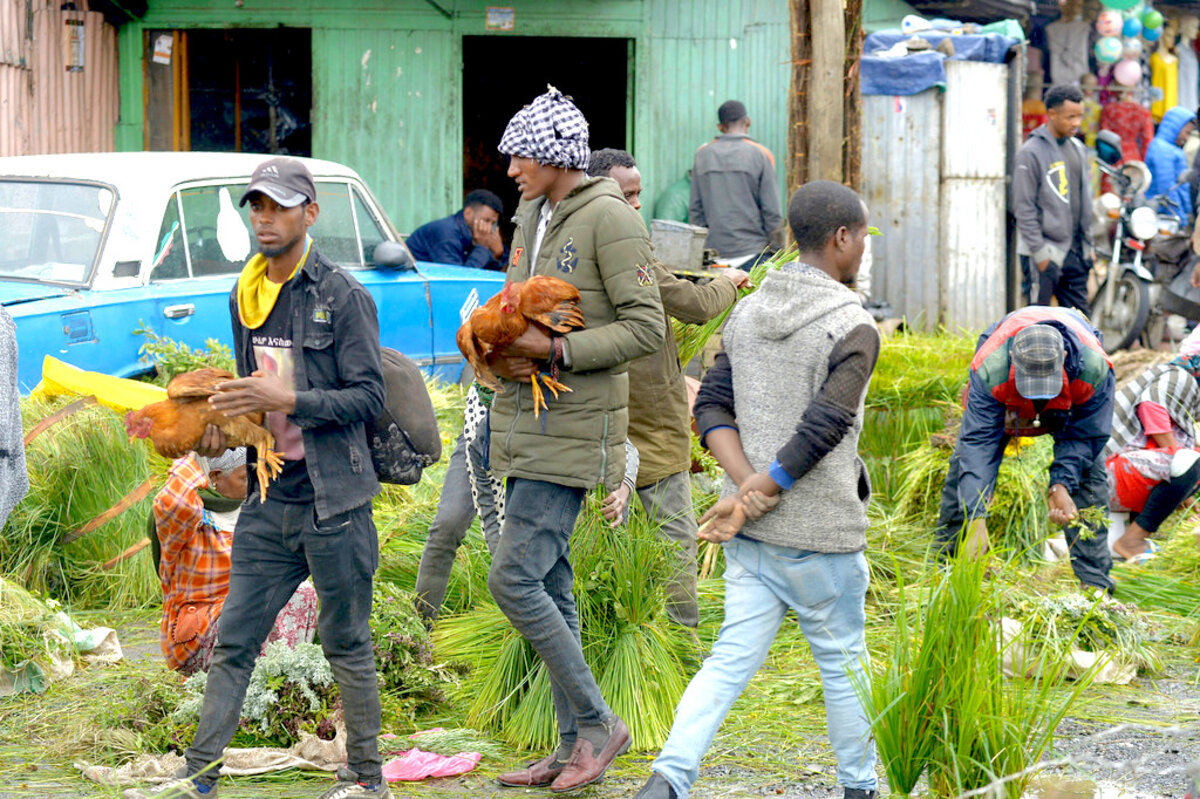
The European Union on Tuesday announced a new effort to help Ethiopia rebuild from an ethnic-driven civil war that still lingers nearly a year after it was brought formally to an end. Then, yesterday, a United Nations mandate for an inquiry into human rights violations during and since the war expired.
The two developments raise a question: Might Ethiopia be a testing ground for new approaches to bringing justice and protection for civilians in a conflict? If so, that possibility may reflect a global shift in how democracies coax reforms in post-conflict countries.
The United States and countries in Europe and Asia have “begun to move closer ... in their emphasis on the shared values that unite them and separate them from their authoritarian rivals,” Princeton political scientist Aaron L. Friedberg notes. Bolstering democratic practices abroad, he wrote for the Center for Strategic and International Studies, requires new approaches in political credibility and economic investment.
Since the genocide in Rwanda in 1994, and arguably further back, individual countries and the international community have embraced truth-telling as indispensable to post-conflict reconciliation and lasting peace. The U.N. inquiry commission, established by the Human Rights Council in 2021, was meant to “provide guidance on transitional justice, including accountability, reconciliation and healing.” On Tuesday, it reported that “most, if not all, of the structural drivers of violence and conflict” in Ethiopia remain unaddressed and require “continued international scrutiny.”
The commission needed the request of at least one member state of the council to keep working. Yet even as the EU commits to postwar reconstruction, no European country made the call. Critics fear that, without the panel’s oversight, potential war crimes will go unpunished. But the E.U.’s new investment plan espouses many of the same goals as transitional justice through other means. This includes investments in essential services that war-affected communities need to rebuild their lives and initiatives that “promote social cohesion, trust, and a culture of mutual respect and dialogue.”
Those investments, starting with an initial EU pledge of nearly $700 million over three years, align with Ethiopia’s own projects to rebuild local economies disrupted by the war. In August, the government estimated it would need $20 billion over five years to rebuild.
Postwar reconstruction involves renewing “a social contract between citizens and the government,” notes Alpaslan Özerdem, dean of the Jimmy and Rosalynn Carter School for Peace and Conflict Resolution at George Mason University, in a Wilson Center blog. In Ethiopia, the EU may be shaping a new model for reform and reconciliation, one that targets investments toward uniting a country around shared values of good governance.

A Christian Science Perspective
Each weekday, the Monitor includes one clearly labeled religious article offering spiritual insight on contemporary issues, including the news. The publication – in its various forms – is produced for anyone who cares about the progress of the human endeavor around the world and seeks news reported with compassion, intelligence, and an essentially constructive lens. For many, that caring has religious roots. For many, it does not. The Monitor has always embraced both audiences. The Monitor is owned by a church – The First Church of Christ, Scientist, in Boston – whose founder was concerned with both the state of the world and the quality of available news.
What is your birthright?
- Quick Read
- Read or Listen ( 4 Min. )
-
By Diane Collins
Since our real origin and inheritance are in and of God, we can expect to feel and experience manifold blessings, including health.
What is your birthright?
In biblical times, and in some cultures today, a birthright entitles a first-born to blessings derived solely from priority in birth order. Christian Science teaches, however, that the true birthright of each one of us is to be the beloved child of God, and opens our lives to freedom from the limitations associated with human existence.
Each of us is entitled to be, indeed is, the child of a perfect, wholly good, Father-Mother God. We are never born into material circumstances and were never destined to inherit a mix of good and bad traits from human parents.. Our origin is never really in a “birth,” but is forever derived from our oneness with all that God is.
Mary Baker Eddy writes in “Science and Health with Key to the Scriptures,” “Jesus acknowledged no ties of the flesh. ... He recognized Spirit, God, as the only creator, and therefore as the Father of all” (p. 31). Jesus knew and relied on his birthright of divine sonship and trusted God’s power to heal. Encountering a man who’d been born blind, he rebuked his disciples’ attempt to identify a cause of the condition, knowing that the man was one with his divine Parent, God, and he healed him.
Looking to God as the one Parent of us all has guided me in parenting. This has included seeing each of my two sons as inheriting all good from their divine Father-Mother.
During my pregnancy with our first son, there were complications, accompanied by predictions that he would be born prematurely with possible abnormalities. This resulted in a week-long hospital stay. It was a challenging but prayerful time for my husband and me.
With the prayers of a Christian Science practitioner, early contractions (that medical intervention had been unable to arrest) stopped, and bleeding was stanched. An ultrasound revealed that the issue believed to have caused the bleeding had been resolved. Observation continued for the week, but with no medication required.
At one point, I overheard a nurse say that another patient was about to lose her premature child, and possibly her own life. As the practitioner and I continued to pray about my own pregnancy, a thought hit me: that every child is a perfectly formed, entirely spiritual idea of God. I pondered this for hours for myself but also broadened my prayers to include all children and parents.
The next day, I heard that the other child and mother were doing well. While I don’t claim this healing was the result of these prayers alone, this reversal of the dire predictions gave me confidence. Two months later, our son was born just a week before his due date. Though the hospital required many tests, he was found to be perfectly healthy.
This healing prepared us to adopt our second son seven years later. He was born prematurely, and as we prayed, clear, reassuring inspiration came. There were many required medical tests, but despite being underweight, he was found to be totally healthy. Within six months, he was a normal weight and a happy, active baby.
Sometimes challenges keep coming, and discouragement sets in. But I have found the words in Hymn 382 from the “Christian Science Hymnal” (Emily F. Seal) to be a complete prayer of affirmation about the spiritual birthright to which each one of us is entitled.
The hymn begins with the question, “What is thy birthright, man,” and the next line answers by affirming our oneness with God: “Child of the perfect One.” Our identity, our birthright, is child of the perfect One – God – and we each inherit, by divine right, all good. Challenges and discouragement are dim shadows dispelled by God, Truth, who knows us each as His perfect child.
“What is thy Father’s plan / For His beloved son?” the hymn continues. “Thou art Truth’s honest child, / Of pure and sinless heart.” And as Truth’s honest child, we each walk “undefiled / In Christly paths apart” – safe and cared for. Nothing defiles God’s children. And all the fears that seem so powerful can be recognized, as the hymn says, as “phantoms” that must “flee before the light” of this understanding.
Finally, when we take “the sacred rod” of authority that directs and governs, we are “not error’s thrall,” enslaved by what’s not true about our identity. We can defend everyone’s inheritance of all that God, Truth, is, which includes a most precious gift: “Dominion over all” that is unlike God, good.
What a birthright!
Adapted from an article published in the Sept. 18, 2023, issue of the Christian Science Sentinel.

Viewfinder
Journalists arrested in India
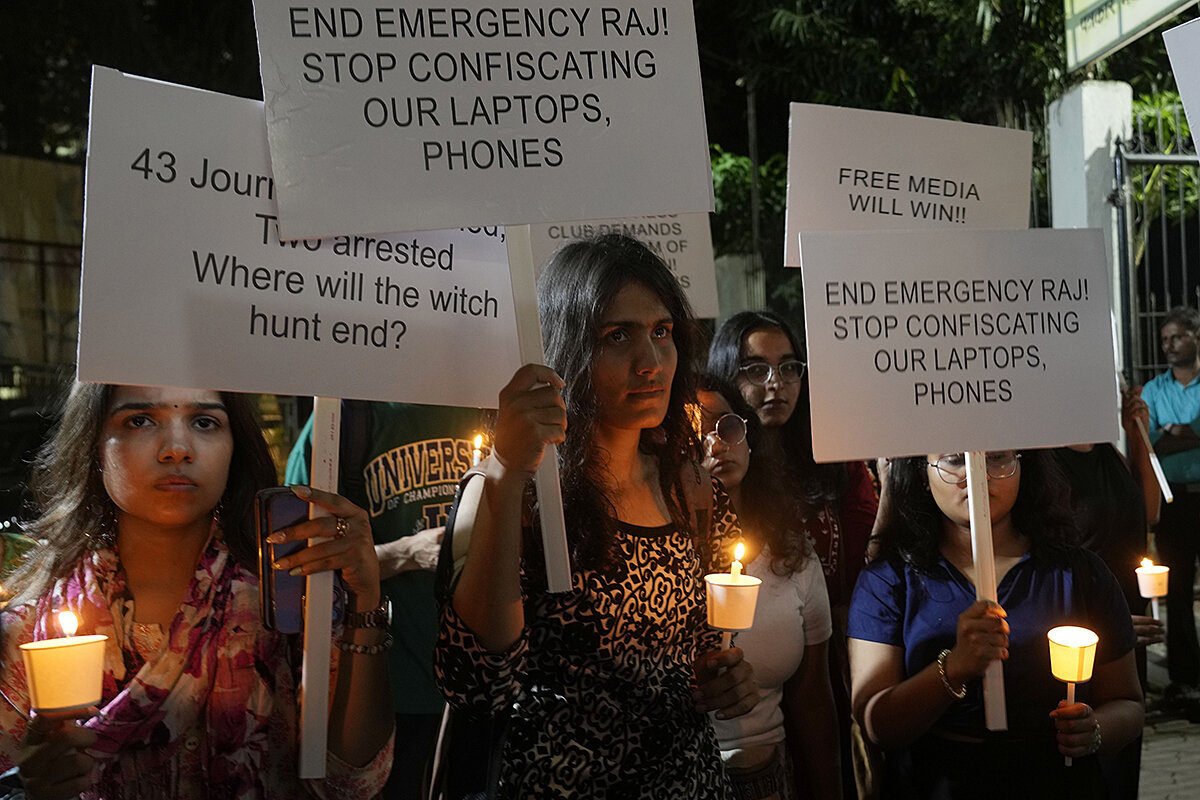
A look ahead
Thank you for joining us today. Please come back tomorrow when we explore an issue that has gained urgency amid the current uncertainty around leadership in the U.S. House of Representatives. Support for the Ukraine war effort has lessened, even if majorities in America and Europe still favor it. What happens now?


